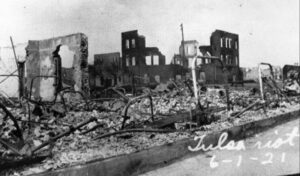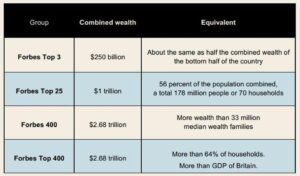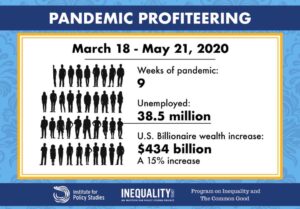I almost never watch the evening news, but this week I can’t not watch.
I was particularly fascinated to see the coverage from Third Street Promenade in Santa Monica, California on Sunday. As several hundred people marched peacefully just a few blocks away, the news team at the Promenade filmed dozens of people looting a high-end, boutique shoe store in broad daylight.
Right before our eyes in real time, people rushed out of the store, their arms piled high with shoe boxes. One man brought his own garbage can, filled it up and dragged it off. It was a “cat and mouse game,” the reporter said; while the police were protecting the protesters, the looters were looting then scattering. By the time the police arrived and arrested several, the store had been mostly emptied of its merchandise.
This audacious looting was happening in plain sight.
This week also marks the 99th anniversary of the Tulsa Race Massacre.
Following World War I, Tulsa was recognized nationally for its affluent African American community known as the Greenwood District. This thriving business district and surrounding residential area was referred to as “Black Wall Street.”
But then in June 1921, some sort of incident between a young Black man and a young White woman sparked a riot. No one knows exactly what happened betwen them, but as has always been true throughout U.S. history, the White people assumed the Black man had done something terribly wrong.

Public officials provided fire arms and ammunition to individuals, all of them white. Units of the Oklahoma National Guard participated in the mass arrests of all or nearly all of Greenwood’s residents.
They removed them to other parts of the city, and detained them in holding centers. Entering the Greenwood district, people stole, damaged, or destroyed personal property left behind in homes and businesses.
People, some of them agents of government, also deliberately burned or otherwise destroyed homes credibly estimated to have numbered 1,256, along with virtually every other structure — including churches, schools, businesses, even a hospital and library — in the Greenwood district.
Despite duties to preserve order and to protect property, no government at any level offered adequate resistance, if any at all, to what amounted to the destruction of the Greenwood neighborhood.
Although the exact total can never be determined, credible evidence makes it probable that many people, likely numbering between 100-300, were killed during the massacre.
Even though this audacious looting happened in plain sight, the history of the massacre was hidden and downplayed for years.
But yes, let’s keep talking about those stolen sneakers.
As the COVID-19 pandemic exploded across the U.S., millions of people lost their jobs and thousands of businesses teetered on the brink of financial disaster. In March, Congress passed a $2 trillion stimulus package, designating $350 billion in small business loans, $250 billion in unemployment insurance benefits and $500 billion in loans for distressed companies.
From the start, however, the president refused to abide by the oversight rules specifically written into the CARES Act and made it clear that loans to large companies would not be subject to any sort of scutiny.
The Inspecter General provision was intended as an accountability effort to alert Congress if the Trump administration was not complying with auditing measures. It was also meant to help ensure the president and his family did not directly benefit from the emergency funds through their businesses.
Sure enough, within days, large public companies were tapping into the funds reserved for small businesses, facilitated by big banks that “prioritized requests from the biggest companies because they would get larger loans and generate bigger banking fees…”
“That left thousands of small businesses — 90% of applicants, according to some law suits — with nothing as the $349 billion in funds for the Paycheck Protection Program (PPP) ran dry…less than 14 days after it launched.”
Revelations that taxpayer handouts intended for small businesses went to major companies instead triggered public outrage and the issue of the funds going to large companies garnered bipartisan attention on Capitol Hill. House Minority Leader Kevin McCarthy (R-Calif) vowed to “go after those big companies that cheat the system.”
This audacious looting has been happening in plain sight.
But yes, let’s keep talking about those stolen sneakers.

Before the pandemic and especially since the 2016 election, inequities within the U.S. economy were already mushrooming. We’ve been hearing for years how national wealth has become more and more concentrated at the top and how a very few ultra rich people control most of the money in this country.
But recently, since the pandemic hit, we have seen a “Billionaire Bonaza” where the rich are getting much much richer while the poor are getting much much poorer.

A recent study found that the combined wealth of America’s 565 billionaires in 2017 stood at $2.7 trillion….
By 2020, the number of America’s billionaires had increased to 614 and their collective wealth to $2.9 trillion…
But by April 10, the number of American billionaires had increased by another 15 people to 629, surging their overall net worth up to $3.2 trillion — a gain that occurred over the course of 23 days during the coronavirus pandemic.
And this audacious looting has been happening in plain sight.
But, yes, let’s keep talking about those stolen sneakers.
Of course I am not condoning the stealing of sneakers or the smashing of windows but during this chaotic time, it’s important for us to keep a balanced perspective; to keep our priorties straight.
If we are more concerned about a few opportunistic looters than we are about the corporate corruption that is stealing the American dream from millions of people, then our priorities need significant adjustment.
If we are more concerned about this recent looting and vandalism than we are about the ongoing violence against our Black sisters and brothers, then our priorities need significant adjustment.
Bobby Kim, co-owner of the prominent streetwear brand The Hundreds in Los Angeles, saw rioting right out his front door and watched as his business neighborhood was vandalized. Still he said he was empathetic to the issues that have sparked protests.
“It was sad to see,” he said of the unrest. “But I’m more sad to see the injustice of this country that continues than I am about losing money.
The customers I sell to are the most important and their lives are at risk. They are my community.
Windows can be replaced.”
Mr. Kim has his priorities straight.
This chaotic time is forcing us to have a long overdue conversation about the economic, social and political violence that is woven deeply into the fabric of our nation.
We (especially we White folks) need to talk honestly about the inequities and injustices that have marked our old normal and raise our voices in protest. Then we need to join our voices and bind our lives together with all those who have been damaged, dismissed and disregarded.
It’s time to have The Talk, America. It’s time for a New Normal.
The CARES Act Has Passed: Here Are The Highlights from Forbes magazine
Trump says he won’t comply with key transparency measures in the coronavirus stimulus bill from Vox
House Coronavirus Panel Demands Large Corporations Return Stimulus Funds from The Hill
Banks Funneled Stimulus Funds To Largest Companies To Fatten Fees, Lawsuits Say from HuffPost
Richest 1% now owns half the world’s wealth from CNBC News (article from 2017)
The 3 Richest Americans Hold More Wealth Than Bottom 50% Of The Country, Study Finds from Forbes (article from 2017)
Institute for Policy Studies’ “Billionaire Bonanza” report analyzed wealth data from the Bloomberg Billionaire Index and Forbes’ Global Billionaires and 400 lists since 1990.
Los Angeles Retailers Clean Up after Looting and Vandalism
Here’s a helpful article: Why People Loot
Two more stories about shopkeepers who have been vandalized but still support the protests
“I Couldn’t Get Mad” from Dallas
‘Let my building burn:’ Owner of restaurant that caught fire in Minneapolis cheers on protesters
I read your guest commentary in Sunday’s paper.
I loved it. And felt so good when I saw that You are in Paris.
We have lived here kinda off and on since 1988. We traveled in our RV a lot till we got so old! When we moved here we joined the First Baptist church and loved our Sunday school class and they became our best friends. I knew they watched Fox, I knew neither Wayne nor I could watch it. But all was OK…till now. By the time the COVID scare got here we were feeling very uncomfortable in our class, and listening to our preacher. All was for Trump. We still cannot understand how they can follow him so devoutly. I don’t think we can go back there?
And We only have a very few friends who believe as we do , that Trump needs to be defeated. So I was delighted to know there is at least one other person who believes as we do.
I think I love you.
Lol
Pat and Wayne Chapman.
Oh. My. Goodness, Pat and Wayne! I love this! And I think I love you too! There is a strong core of good, like-minded people here in Paris. Watch for an email from me. I’m so glad to meet you! Hugs, Charlotte
I’d like to share with you some readings on looting (shared Google file):
https://drive.google.com/file/d/1P2nHaFVlnEoAGn1Yp2z-dPnnuOZqfK_L/view?usp=sharing
My Book Club read Rebecca Solnit’s “A Paradise Built in Hell: The Extraordinary Communities That Arise in Disaster”, and learned a lot about “looting” especially with regard to Hurricane Katrina. (Recent Katrina anniversary coverage showed that journalistic “history” had institutionalized the wrong emphasis on survivors being violent rather than authorities blocking them from aid because of authorities assuming Blacks would be violent.) I thought I’d share some quotes that I just copied from the Kindle book.
Thanks Jeanne!